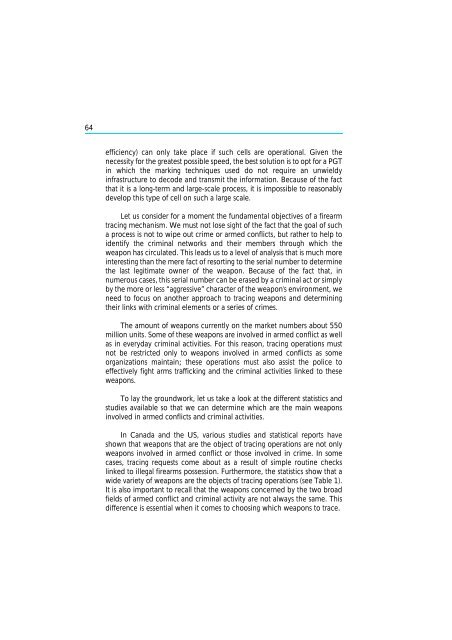The Scope and Implications of a Tracing Mechanism for Small Arms ...
The Scope and Implications of a Tracing Mechanism for Small Arms ...
The Scope and Implications of a Tracing Mechanism for Small Arms ...
Create successful ePaper yourself
Turn your PDF publications into a flip-book with our unique Google optimized e-Paper software.
64<br />
efficiency) can only take place if such cells are operational. Given the<br />
necessity <strong>for</strong> the greatest possible speed, the best solution is to opt <strong>for</strong> a PGT<br />
in which the marking techniques used do not require an unwieldy<br />
infrastructure to decode <strong>and</strong> transmit the in<strong>for</strong>mation. Because <strong>of</strong> the fact<br />
that it is a long-term <strong>and</strong> large-scale process, it is impossible to reasonably<br />
develop this type <strong>of</strong> cell on such a large scale.<br />
Let us consider <strong>for</strong> a moment the fundamental objectives <strong>of</strong> a firearm<br />
tracing mechanism. We must not lose sight <strong>of</strong> the fact that the goal <strong>of</strong> such<br />
a process is not to wipe out crime or armed conflicts, but rather to help to<br />
identify the criminal networks <strong>and</strong> their members through which the<br />
weapon has circulated. This leads us to a level <strong>of</strong> analysis that is much more<br />
interesting than the mere fact <strong>of</strong> resorting to the serial number to determine<br />
the last legitimate owner <strong>of</strong> the weapon. Because <strong>of</strong> the fact that, in<br />
numerous cases, this serial number can be erased by a criminal act or simply<br />
by the more or less “aggressive” character <strong>of</strong> the weapon's environment, we<br />
need to focus on another approach to tracing weapons <strong>and</strong> determining<br />
their links with criminal elements or a series <strong>of</strong> crimes.<br />
<strong>The</strong> amount <strong>of</strong> weapons currently on the market numbers about 550<br />
million units. Some <strong>of</strong> these weapons are involved in armed conflict as well<br />
as in everyday criminal activities. For this reason, tracing operations must<br />
not be restricted only to weapons involved in armed conflicts as some<br />
organizations maintain; these operations must also assist the police to<br />
effectively fight arms trafficking <strong>and</strong> the criminal activities linked to these<br />
weapons.<br />
To lay the groundwork, let us take a look at the different statistics <strong>and</strong><br />
studies available so that we can determine which are the main weapons<br />
involved in armed conflicts <strong>and</strong> criminal activities.<br />
In Canada <strong>and</strong> the US, various studies <strong>and</strong> statistical reports have<br />
shown that weapons that are the object <strong>of</strong> tracing operations are not only<br />
weapons involved in armed conflict or those involved in crime. In some<br />
cases, tracing requests come about as a result <strong>of</strong> simple routine checks<br />
linked to illegal firearms possession. Furthermore, the statistics show that a<br />
wide variety <strong>of</strong> weapons are the objects <strong>of</strong> tracing operations (see Table 1).<br />
It is also important to recall that the weapons concerned by the two broad<br />
fields <strong>of</strong> armed conflict <strong>and</strong> criminal activity are not always the same. This<br />
difference is essential when it comes to choosing which weapons to trace.
















